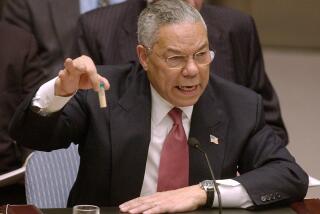Which Way Out?
- Share via
On the deadliest day of the Iraq war, with 31 troops killed in a helicopter crash and six more in insurgent ambushes, President Bush’s response was that the crash would be “very discouraging to the American people.” The president has a gift for understatement when it comes to the war; discouragement has long since given way to anger, both at the Iraqi insurgents and the U.S. administration that got us into this mess.
After nearly two years, the deaths of more than 1,400 troops and the expenditure of well over $200 billion, Bush still refuses to spell out an exit strategy. Instead, he speaks of bringing the troops home “as soon as possible” and hails Sunday’s election for an interim national assembly.
The onetime goal of ridding the country of weapons of mass destruction went by the boards when it turned out there were no such weapons. The new target is Iraq as a launching pad for democracy in the Middle East. But the more immediate result has been to create a new rallying point for Islamic fundamentalists.
U.S. officials say American troops will stay until Iraq can protect itself. Does that mean years, decades? A top general said Monday that the Army expects to keep 120,000 troops in the country for at least two years, unless attacks by insurgents lessen or Iraqi forces become more capable.
But troop deployments have stretched the Army greatly and forced the call-up of large numbers of reserves and National Guard troops. The commander of the Army Reserve said last month that “dysfunctional” Pentagon policies have hurt morale and threaten to turn the 200,000-strong organization into a “broken force.”
American citizens, who are paying the bill for all this and watching their neighbors or loved ones die in combat, deserve more than comforting platitudes from the president. They deserve to know how long it is expected to take to train Iraqi soldiers, police and other security forces. Can 50,000 of the 150,000 U.S. troops now in Iraq come home when 20,000 Iraqi soldiers and 100,000 police are trained? What will it take to bring the next 50,000 Americans home?
We’ll need evidence to support the claims of progress and estimates, not just someone’s word; we remember the administration’s claims about weapons of mass destruction and its lowballing of the war’s cost in money and troops. When the Army chief of staff, Gen. Eric K. Shinseki, said before the war that it would take several hundred thousand troops to pacify the country, Deputy Defense Secretary Paul D. Wolfowitz called the figure “wildly inaccurate.” When the director of the president’s National Economic Council, Lawrence Lindsey, estimated the war would cost $100 billion to $200 billion, administration officials said the figures were too high. Shinseki was sidelined, and Lindsey was fired.
Iraq is not Vietnam, but an open-ended commitment of troops and the talk of using increasing numbers of soldiers as “trainers” for Iraqi forces summon ghosts of quagmire and years of deceit that ravaged an army and a nation. We can’t afford to walk down that trail again.
More to Read
Sign up for Essential California
The most important California stories and recommendations in your inbox every morning.
You may occasionally receive promotional content from the Los Angeles Times.













